மதுராந்தகம் வட்டம், நெட்ரம்பாக்கம் என்ற ஊரில் சிவாலயத்தில் உள்ள பழைய சிவலிங்கத்தில் தமிழ் பிராமிக் கல்வெட்டுக் கிடைத்துள்ளது. அதுபொஆ 2 - 3ம் நூற்றாண்டைச் சார்ந்தது எனக் கல்வெட்டியல் துறையினர் கணித்துளர். “சேநருமான்” என எழுதிய கல்வெட்டு.
Siva Linga with early Brahmi inscription found
B. KolappanD.Madhavan CHENNAI:JANUARY 20, 2016
A Siva Linga with an early Brahmi inscription dating back to the first century AD has been found in Nandeshwar temple at Netrumpakkam village in Maduranthakam taluk in Kancheepuram district.
It could be the oldest Siva Linga in Tamil Nadu. The oldest Siva Linga in the country is in Gudimallum near Tirupati. An old Sivalinga with inscription is in Mathura.
Archaeologist R Nagaswamy said Netrumpakkam itself was very old and the presence of a granite stone belonging to the megalithic period confirmed its antiquity.An idol of Durga worshipped as Ponniamman belonging to the Pallava period was unearthed, he said.
The lingam was found during renovation for the kumbabishekem (consecration) of a temple to be held in January 20. Panchayat president K. Prema Krishnamurthy immediately alerted the archaeologists.
Mr. Nagaswamy, who visited the temple on Monday, said the lingam with a square shaped Avudai had an inscription at the bottom reading CE N DA MAAN “Five lotuses were drawn with the middle flower blooming,” he said. T.G. Loganathan, epigraphist of the State Archaeology Department, said the word might be a name of a sculptor.
“More research will throw light on the subject,” said Mr. Loganathan who along with G. Arjunan, former deputy superintendent archaeologist of the Department, Loganathan decoded the inscription in the Lingam after visiting the Shiva temple. As per archaeological records, the inscription at the Sri Kailasanathan temple on ECR belonged to 9{+t}{+h}century.
The inscription at Nandeshwar temple pushes the Tamil-Brahmi script in Tamil Nadu to a very early period. “The finding of the inscription is significant because it takes the origin of Tamil–Brahmi script in Tamil Nadu several centuries earlier than it was believed so far,” said K. Sridharan, former deputy director, Tamil Nadu Archaeology Department.
Archaeologists had found Tamil–Brahmi inscriptions on bedrocks near caves where Jain monks had settled. Some of the noted Jain settlements are Kongarpuliyankulam in Madurai, Arunkulam near Tirutani in Tiruvallur district, Onambakkam and Perumbakkam in Kancheepuram district.
Archaeologists say it could be the oldest lingam in State
Fig. 3.1 Netrmambakkam Brahmi inscription ~ cē na ru mā na
In 2016, Tamil Brahmi inscription on a large linga in Netrambakkam village Śiva temple was discovered. Dr. R. Nagaswamy read the inscription as, "cēntamān", https://www.thehindu.com/news/cities/chennai/Siva-Linga-with-early-Brahmi-inscription-found/article14009612.ece
However, upon re-examination, it is read as "cēnarumān", with cēnaru = armyfolk. cēnarumān will be son/heir of warriors. cēnaru is a tadbhava from sena, a Sanskrit word, while cēntan is Tamil for Murukan-Skanda. The most significant aspect of both the Netrambakkam and Kinnimangalam lingas is that they have to be rotated upside down for reading the script. From Tamil verb, cāy-tal, Sanskrit nouns like sayana 'bed', śava 'corpse' are derived. Extreme cāytal is 180 degree turn limit and this is done in memorial linga writing. The Netrambakkam lingam has Neytal 'blue water lily, nymphaea violacea' flowers, plant-symbol of Neytal Littoral (Sea) Landscape in Sangam texts showing the ancient connection of Linga form with Varuṇa, the neytal god. neytal paṟai is 'death drum' which Tiruvalluvar calls as "paṭāap paṟai". The Netrambakkam inscription, with Neytal flowers and leaves, is dated to 2nd or 3rd century CE. Similar date can be assigned to Kinnimangalam image and inscription.
However, upon re-examination, it is read as "cēnarumān", with cēnaru = armyfolk. cēnarumān will be son/heir of warriors. cēnaru is a tadbhava from sena, a Sanskrit word, while cēntan is Tamil for Murukan-Skanda. The most significant aspect of both the Netrambakkam and Kinnimangalam lingas is that they have to be rotated upside down for reading the script. From Tamil verb, cāy-tal, Sanskrit nouns like sayana 'bed', śava 'corpse' are derived. Extreme cāytal is 180 degree turn limit and this is done in memorial linga writing. The Netrambakkam lingam has Neytal 'blue water lily, nymphaea violacea' flowers, plant-symbol of Neytal Littoral (Sea) Landscape in Sangam texts showing the ancient connection of Linga form with Varuṇa, the neytal god. neytal paṟai is 'death drum' which Tiruvalluvar calls as "paṭāap paṟai". The Netrambakkam inscription, with Neytal flowers and leaves, is dated to 2nd or 3rd century CE. Similar date can be assigned to Kinnimangalam image and inscription.
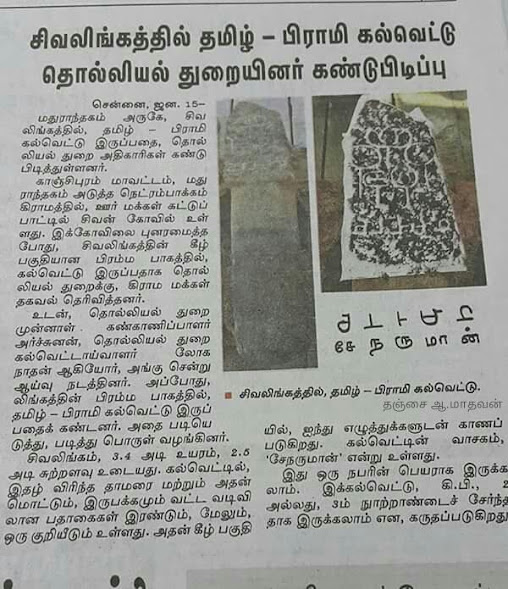
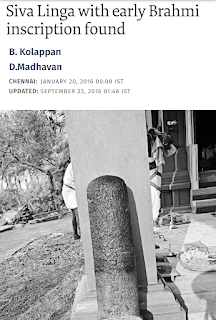
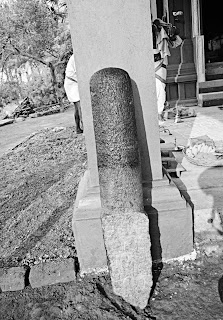
.jpeg)
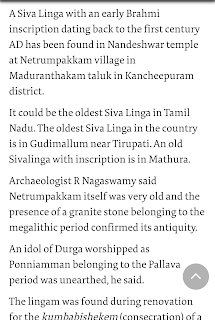
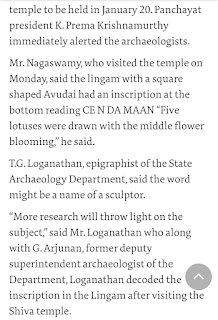
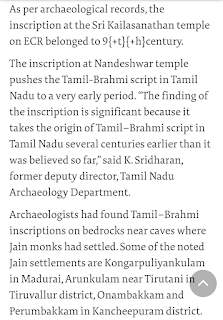



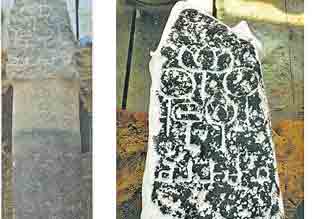

No comments:
Post a Comment